|
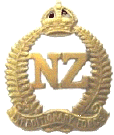
|
| Category: Army
History/WW2 |

|
|
|
|
|
|
BRITISH
FREE CORPS in the WAFFEN SS – Aussies fighting for Hitler |
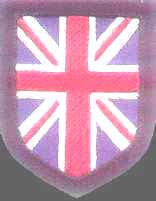 |

|
|
The Cuff title of the
BFC |
| <<<
Sleeve badge of the Britisches
Frei-Korps |
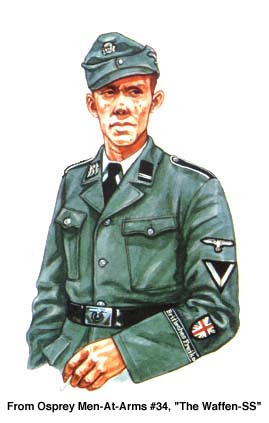 |
Aussies
& Kiwis in Hitler's Army |
|
Time
and again contradictory information
about numbers and “battle” feats
of the British detachment in SS-Waffen, which
included several Australians, keep turning out in various books
and Internet publications. For example till recently one could have come
across allegations or speculations that this group of people took part
in the defence of Berlin in April-May 1945. The most comprehensive data
based on document declassified in 1980-90-ties was given in the book
"Renegades. Hitler’s
Englishmen” (Adrian
Weale, 1994). This
page is based on that book. It has to be
emphasized that this story does not relate to the other group of the
British renegades which took part in Nazi propaganda war targeted
against Great Britain.
This
text is copied from http://argo.net.au/andre/renegades_ENFIN.htm
|
This
detachment commenced formation in the second half of 1943 when the
strategic-military situation of Germany
had greatly deteriorated. Volunteer POWs from Great Britain and her
dominions became the main source of servicemen for the detachment. The
first Commander of the Corps was Hauptsturmfurer SS Hans Werner Roepke –
an English-speaking German.
Initially
6 men comprised the Corps: Thomas Cooper, Fransis MacLardy, Roy Courlander,
Edward Martin and Alfred Minchin. It was so called ‘Big Six” of rather
hard line Nazi who were involved into recruitment of new members. What
kind of people were they?
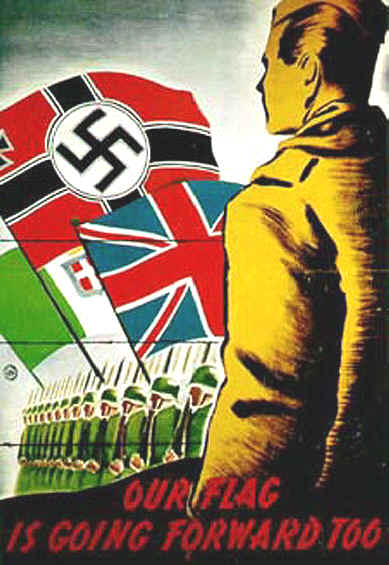 |
Cooper,
a son of an Englishman and a German woman, applied to
join Police College, RN and RAF before the war
but was rejected because of his partially German background.
The
disappointed man joined the British Union of Fascists (BUF) and in 1939
went to travel to Germany with his mother. His was caught by the war there
and faced a difficult choice – to be interned as a British subject or to
be drafted into the German Army.
The chose the latter and later served in
various detachments of the Totenkoph Division.
In
1941 he was in Poland and later bragged of his participation in murders of
Poles and Jews.
He spent some time at the Eastern Front and was wounded. |
MacLardy,
former pharmacist and BUF member from Liverpool
was captured by Germans in Belgium in 1940 and in 1943 after a series of
illnesses joined BFC having decided that he “would not survive another
Polish winter” (his POW camp was in Poland
– VK).
| Roy
Courlander, a son of a Lithuanian Jew and an English woman was born in
London, served in New Zealand Army and
was captured in Greece in 1941.
He posed as a “White
Russian émigré” and was typical of extremely anti-Russian views.
Before he joined BFC he had participated in the Nazi broadcast for England
Little
is known about the past of Canadian Edward Martin who was captured after
failure of the Dieppe landing.
Alfred Minchin – a merchant seaman from SS
Empire
Range – was captured after his ship had
been sunk en route to Murmansk. Later he told that he had joined BFC
reckoning that it was purely a propaganda unit. Former Sergeant John
Wilson was probably coerced into joining the Corps. |
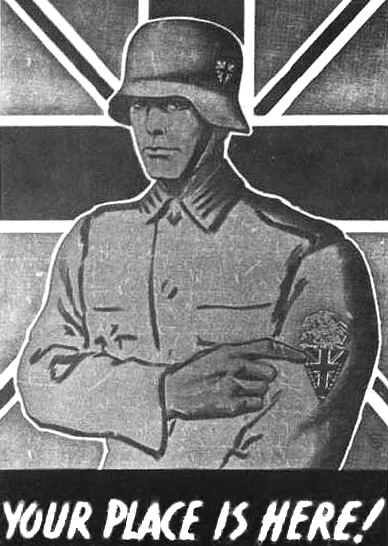 |
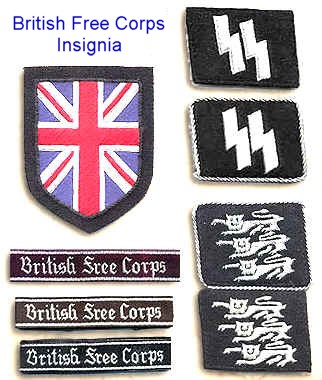 |
In
February 1944 the Corps already numbered 8 “free Britons” although it
is noteworthy that the composition of BFC had been constantly changing:
people had been coming and going.
Former boy seaman of the Royal Navy
Kenneth Berry who was captured in 1940 when he was only 14 also joined the
Corps.
But already in March Martin quit and returned to POW camp.
Soon a few more people joined the Corps: Robert Heighes, Robert Lane,
Norman Rose, Wood
(Australian) and Thomas
Freeman. |
The
latter was fully acquitted after the war as he had managed to prove that
his aim was sabotage the whole project and escape. Once upon a time he was
a member of BUF and shared their anti-Communist and anti-Semitic views but
during his time in BFC he really conducted anti-Nazi propaganda amongst
his co-servicemen and instigated them to escape. Being involved in
recruitment he would chose people whose interests were far from the aims
of BFC and who as he told the British investigators later, “would bring
only chaos”. Thus Freeman and Wilson recruited Australians
Chipchase and Albert Stokes and
Sergeant Theo Ellsmore – Belgian who masqueraded as South African.
Chipchase spent in BFC only several days and returned to the camp. Stokes
was Freeman’s friend and initially intended to participate in sabotage
of the project…
In
spring 1944 the “free Britons” were involved in recruitment of new
members in POW camps. During this period of time BFC was joined by William
How, former lance-corporal of Military Police, and Ernest Nichols who used
to be a petrol storekeeper in the army. In May-June they were joined by
former merchant seamen Herbert Rowlands and Roland
Barker (Australian).
Ironically enough Rowlands fought in Spain in the ranks of International
Brigade during the Civil War, deserted it and later joined BUF. Barker was
later characterised by Cooper as a man of very low intelligence – he
joined BFC attracted by prospects of an access to better food, alcohol and
women…
In
June John Leister and Eric Pleasants joined. Pleasants was a former member
of BUF and in the past refused to serve in the army on the ground of his
pacifist views. Leister was born in London
in a German family, in 1935-36 he lived and
studied in Germany. Pleasants and Leister worked on one of the British
islands in the English Channel (doing alternative service) in 1940, found
themselves in the area of German occupation and managed to have looted a
few houses abandoned by refugees and finally, when attempting to escape to
England on a motorboat, were captured by Germans and sent to a prison in
France for six months. They eventuated in prison camp for merchant seamen.
They joined BFC because of the same reasons – hoping to have better
food, alcohol and access to women.
Amongst
the novices of the spring-summer draft were also Harry Dean Bachelor,
former sapper, Hugh Cowie (previously made several attempts to escape and
joined BFC to avoid court-martial for possession of banned radio-set); Roy
Futcher (joined of fear to be court-martialled for relations with German
women); Frank Maton, before the war – a BUF member, later corporal in
commando units and participant of Nazi broadcasting for England; and Tom
Perkins, former lance-corporal of Military Police. Out of these people
only Maton was distinguished of his pro-Nazi convictions. In June BFC
reached numbers of 27 people.
This is a short
extract. More
details. |
 |
THE NEW ZEALAND NAZI |
| Roy Courlander in SS Uniform |
|
|
Copied from http://www.armymuseum.co.nz |
During World War
Two, the military wing of the German Nazi organisation, the Waffen SS,
began forming units of foreign nationals to fight for Germany. These units
were mostly recruited from sympathisers who came from the countries
occupied by Germany and most believed they were going to fight the
Russians. One of these units was the Legion of St George, later known as
the British Free Corps (BFC).
An early volunteer for the BFC was Lance Corporal Roy Courlander of the
2nd New Zealand Expeditionary Force (2 NZEF).
Roy was born in London, England, on 6 December 1914 and was greatly
influenced as a boy by the attitudes and opinions of his Lithuanian
stepfather, who had married his mother in 1920. When his parents divorced
in 1933, the 19 year old Roy went to Vanuatu in the Pacific where he
worked with his father on a copra plantation. At some stage, Roy had moved
back to New Zealand and in 1939, he was living in Napier, where he was
convicted of breaking and entering as well as an assault charge. On 3
October 1939, Roy enlisted in the 2 NZEF and went off to Egypt with 18
Battalion and because of his knowledge of German, he was attached to the
Intelligence Section.
In May 1941, now a Lance Corporal, Roy was captured during the retreat
through Greece. As a prisoner of war in Stalag XVIIIA, Roy became the camp
interpreter and soon after volunteered to fight for the Germans against
Russia. In June 1943, Roy went to a special camp just south of Berlin
where he broadcast propaganda for the German foreign radio service. It was
at this time that Roy was issued his German SS uniform.
In April 1944, Roy was promoted to Unterscharfuehrer (Waffen SS Sergeant)
and he began touring prison camps trying to recruit others, especially New
Zealanders. He succeeded in persuading six men from 28 Battalion to
volunteer, but they were eventually turned down by the SS. During one
recruiting visit he was punched in the face by an outraged New Zealander.
Despite its grand title the BFC was never more than 30 strong and the
Allied invasion of Europe in June 1944 signalled its demise. As the Allies
advanced, the BFC began to disintegrate, with its members deserting or
trying to rejoin the ranks of liberated prisoners of war. At the end of
September 1944, Unterscarfuehrer Roy Courlander surrendered to the Allied
Forces in Belgium.
Lance Corporal Courlander was arrested and tried by court martial by the
New Zealand military authorities in Margate, England, and on 3 October
1945, six years to the day after enlisting, Roy was sentenced to 15 years
in prison. In 1946, he was transferred to Mount Eden prison in Auckland,
New Zealand, until his release in 1951. It is believed that Roy Courlander
left New Zealand in the 1960's and that he died in Australia in 1970. |
|